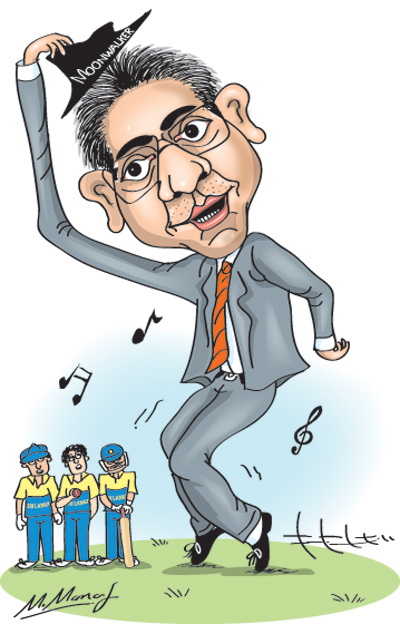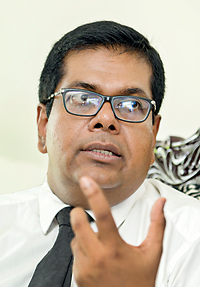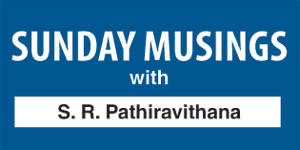Sports Law and the moon walk
View(s):
The Sports Minister was moving backwards with a forwards motion
Confusing times; it was only last week, a group of Lanka cricket’s stakeholders met Sports Minister Faiszer Musthapha and discussed the consequences of the delays in holding tournaments. May be, it was within the periphery of the minister’s authority; the results were prompt and two weeks hence, club cricketers will be back in their dressing rooms padding up to take part in the revived under 23 tournament.
The under 23 club tournament was withdrawn from the club realm by some vision-less miscreants and now it is back or it seems like that. That is the feeder point to the premier cricket tournament which will begin late November. This means that local cricket is back on track.
However, the last that we heard was that the under 23 tournament may be played subject to approval and the availability of finances.
Yet, within the bigger picture in cricket, the paint is still wet, and the picture does not get clear because the sports minister keeps pushing the brush up and down, and the result is nothing concrete is laid beneath the cricket conundrum prevailing now.
Honestly, we think from the first move, he pushed the wrong pawns across cricket’s chess board. First, it appeared that he was in a mighty hurry to restore the reins to the last regime. But, with the case filed by former Sri Lanka Cricket secretary Nishantha Ranatunga on several matters pertaining to the cricket election and its formation, the events started to unfold one by one. Now, in reality, it looks as if the minister is doing a “Michael Jackson” moon walk – moving backwards with a forwards motion. Is it really needed? Isn’t the Sports Law sufficient to deal with the problem at hand? Or is it that an unseen hand is pulling him back? It appears that Minister Musthapha is keen to end this bad dream but, there are demons under his bed.
We asked Sports Law expert Panduka Keerthinanda how he would explain this situation. He went to the beginning of the stairway – the first step. He explained, “We had the first Cabinet in 1947 and we had only 14 ministers. The first sports minister was appointed during the tenure of Prime Minister Dudley Senanayake. He was V.A. Sugathadasa. As some may remember, he was very effective and ended up remaining immortal with the Sugathadasa Stadium. They built it and named after him, because he was effective and there were results in his projects.”
Keerthinanda, however, says the catalyst was Sports Minister K.B. Ratnayake. In 1970, when the Samagi Peramuna government came to power, K.B. Ratnayake was appointed minister of sports. Then, in 1973, he introduced Act No. 25 – it came to be knows as the Sports Law of Sri Lanka.

Keerthinanda, however, says the catalyst was Sports Minister K.B. Ratnayake. In 1970, when the Samagi Peramuna government came to power, K.B. Ratnayake was appointed minister of sports. Then, in 1973, he introduced Act No. 25 – it came to be knows as the Sports Law of Sri Lanka.
“Thereafter, there were a few amendments to the Sports Law – in 1993, 1998 and 2005. Especially in 1993, during the tenure of Minister Nanda Mathew, he made an amendment making it compulsory that the Olympic Committee and All Sports Bodies of Sri Lanka be audited by the Auditor General of Sri Lanka. It had great significance. It gave all sports bodies an insight on how to run their respective administrations. State funds are being used by the sports bodies and, in turn, they had to be accoutable to the government.”
He also said, “At the same time, we have the Sports Fund run by the Sports Ministry, and that really became operational only in the 1980s. Through that, the minister had the responsibility of running the sports bodies effectively. Sports, in this country, are run on three pillars – the Sports Law, Sports Regulations and the Sports Policy. Besides, there are some other international sports charters that the Lankans have to follow. Those are the criteria which envelope Sports and the Sports Law of this country”.
Keerthinanda said it is the duty of the minister of sport to control, develop and sustain sports through state patronage.
He added: “Speaking of cricket, during the past three years, there have been three ministers of sports. It was like changing the pillow at a children’s party musical chairs. Every year, there is a change in the ministry of sport. The Sports Regulations were set in place in 2016, while there were some errors in the Sports Law, thereby, some parties lost the opportunity of contesting, while some others received undue privileges. In 2016, the Sports Regulations were amended by the then sports minister Dayasiri Jayasekera. He gave stringent directives under the Sports Law, which culminated in the present Legal tangle that cricket is enveloped in.
“What the Sports Minister should do is, he should apply the National Sports Policy, Sports Law and Sports Regulations and, if the Regulations are erroneous, he must amend them immediately. To do that, he must have proper guidelines and proper advice. But, it is sad to say that, so far, the National Sports Council which acts as a guide in matters of this nature, has not been formulated as yet. So, from where does he obtain professional advice? Who is there to cater to his needs?”
In the same breath, Keerthinanda pointed out that, by not heeding to the advice of the National Sports Council, by not appointing one, the minister goes ahead and appoints his own permanent secretary as Competent Authority of Sri Lanka Cricket. “Now because of this, there is a conflict of interest. For example, the situation where there is a fraud being investigated and a senior SLC official taken into custody by the Criminal Investigation Dept of the Police.”
“Now who is in charge of SLC at the moment? It is the Sports Ministry Secretary. Now this has happened when SLC’s competent authority is in the chair. So isn’t there a conflict of interests? I feel the initial investigation has to be conducted by the Ministry Secretary — and now we find both persons are one and the same.”
 Under Section 32, he cannot give a directive to conduct the initial inquiry! Keerthinanda said the Minister of Sport has gone on the wrong track and appointed the Ministry Secretary to the position of competent authority of SLC, without appointing an interim committee, or making a suitable interim arrangement to conduct the activity of that national sports body – cricket, under Section 33. “Now he says he had made some changes to the Sports Regulations in September. There, too, there are some grey areas. He has categorised sports bodies into to A, B and C. It says, if the sport has 25 clubs and the annual turnover is more than Rs 50 million, it will be placed in category ‘A’. If a sport has 15 clubs and the annual turnover is between Rs 50 million and Rs 10 million, it will be category ‘B’. If the annual turnover is less than Rs 10 million, that sport will be put in category ‘C’.
Under Section 32, he cannot give a directive to conduct the initial inquiry! Keerthinanda said the Minister of Sport has gone on the wrong track and appointed the Ministry Secretary to the position of competent authority of SLC, without appointing an interim committee, or making a suitable interim arrangement to conduct the activity of that national sports body – cricket, under Section 33. “Now he says he had made some changes to the Sports Regulations in September. There, too, there are some grey areas. He has categorised sports bodies into to A, B and C. It says, if the sport has 25 clubs and the annual turnover is more than Rs 50 million, it will be placed in category ‘A’. If a sport has 15 clubs and the annual turnover is between Rs 50 million and Rs 10 million, it will be category ‘B’. If the annual turnover is less than Rs 10 million, that sport will be put in category ‘C’.
“Sure enough, only cricket may be placed in category ‘A’ in this chart, but where would we place our national sport Volleyball in the chart. Where does that fall into?”
PS: Our contention is that sport belongs to the sport and now any minister. That is why 1973 the then sports minister K.B. Ratnayake primarily put the sports in law place. It is there to be used to the well-being of sports and sportspeople and not to be misconstrued by persons who seek short measures.


